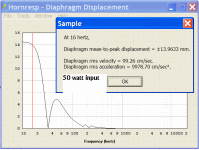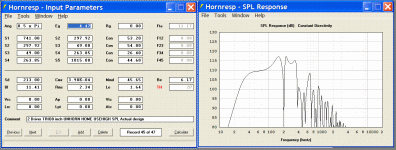Is there any possibility to model two drivers at independent locations within Hornresp or do I have to bite the bullet and work out how to actually use AkabaK? I play with it but I must admit that I don't fully understand what I'm doing yet.
Hi Mark,
Sorry, you are just going to have to learn how to use AkAbak 🙂.
Perhaps you could start with a Hornresp-generated AkAbak script, and then modify as necessary. That is what most other people seem to do.
Kind regards,
David
Ok a bit of clear plastic and a new driver will tell me what is going on to a certain extent. And that is what will happen tomorrow.
Otherwise I will play with this a bit more and post what happens.
Mark
Otherwise I will play with this a bit more and post what happens.
Mark
Hi Patrick ( I have no idea where I came up with John this evening )
If I read this correctly this is the driver parameters section for AkaBak.
Sd=128.3cm2
Bl=8.46Tm
Cms=10.02E-04m/N
Rms=2.09Ns/m
fs=34.0000Hz |Mmd = 1.69g not recognised by AkAbak, fs calculated and used instead
Le=0.75mH
Re=6.40ohm
ExpoLe=1
The specs do not match the TRIO8 or the MCM driver. So this can't be a valid comparison. It is an interesting comparison but not a valid one.
Mark
I thought you were still using a CSS SDX 7 - that's what I used in the sim.

Now that I look at the pic, yeah, this is a Trio 8.
The reason that you can't tell when the woofer is about to blow up is that it's not failing due to overheating. It's failing due to overexcursion. As you blow through the excursion limits, you should hear a "cracking" noise. Until you reach the excursion limits, it's basically going to behave like a dipole subwoofer. Dipole subs can sound quite good, but lengthening the distance from the front to the back of the cone will improve its power handling.
Hi Patrick
Using the pic you referenced this is not the driver that has the trouble. This driver that quite a few people feel is totally unloaded is the one that is perfectly fine. It actually has quite a bit of loading of air mass on one side of the diaphram the mouth side. The inner side has the benefit of being in the smallest area of horn expansion. Just as the pics you displayed one side of the horn is totally unloaded and the other side is. The driver on the very inside is the one that I have had trouble with.
When I check back on all my measurements I see that before I ran any power tests there was a very noticeable glitch in the impedance graph. One indicative of a voice coil rubbing or some other obstruction. Why I did not take any note was I was dying to hear how this box worked (or not I guess).
It worked well for quite a while 4 days an average of 4 1/2 hours/day so what is that 18 hours. Not really all that bad. I ran all kinds of music through it and it came off sounding great. So I have still to determine what the failure mode was. I whole heartedly agree that it is possible to kill a driver with over excursion. What the young men were asking the box to do was some very deep sound effects that the box simply was not capable of producing. The rattle effect is a dead give away. I have been doing this for more than 20 years and yes I have killed woofers before so this not a new experience. But I was only a foot away from the box with ear plugs in and very carefully listening for exactly that rattling effect. I didn't hear it. But I have to get the driver out to actually see what it was that killed it. Work gets in the way of fun though and today I have just enough time to get it done. I'll post what I find out.
Mark
Using the pic you referenced this is not the driver that has the trouble. This driver that quite a few people feel is totally unloaded is the one that is perfectly fine. It actually has quite a bit of loading of air mass on one side of the diaphram the mouth side. The inner side has the benefit of being in the smallest area of horn expansion. Just as the pics you displayed one side of the horn is totally unloaded and the other side is. The driver on the very inside is the one that I have had trouble with.
An externally hosted image should be here but it was not working when we last tested it.
When I check back on all my measurements I see that before I ran any power tests there was a very noticeable glitch in the impedance graph. One indicative of a voice coil rubbing or some other obstruction. Why I did not take any note was I was dying to hear how this box worked (or not I guess).
An externally hosted image should be here but it was not working when we last tested it.
It worked well for quite a while 4 days an average of 4 1/2 hours/day so what is that 18 hours. Not really all that bad. I ran all kinds of music through it and it came off sounding great. So I have still to determine what the failure mode was. I whole heartedly agree that it is possible to kill a driver with over excursion. What the young men were asking the box to do was some very deep sound effects that the box simply was not capable of producing. The rattle effect is a dead give away. I have been doing this for more than 20 years and yes I have killed woofers before so this not a new experience. But I was only a foot away from the box with ear plugs in and very carefully listening for exactly that rattling effect. I didn't hear it. But I have to get the driver out to actually see what it was that killed it. Work gets in the way of fun though and today I have just enough time to get it done. I'll post what I find out.
Mark
Attachments
Last edited:
Mark called me ealier today telling me that we blew a driver on one of our test runs. It seems odd as since he's switched out the driver, there have been no issues. Apparently the 22-27hz bassline on Vast Aire's Ocean Spray (Medley) was pretty abusive. If you havent heard this song on a decent system, i'd strongly encourage it. even if you hate rap, the bass is somewhat of a unique experience. (don't blame me for your speakers unloading though, i gave you fair warning.)
Hi Patrick
Using the pic you referenced this is not the driver that has the trouble. This driver that quite a few people feel is totally unloaded is the one that is perfectly fine.
FWIW, based on that picture of the internals, both of the drivers look they'll unload very easily.
Looks can be very deceiving
Things in loudspeaker horns are not always what they appear to be. I have had umpteen posts publicly and privately about the first box. How the drivers will self destruct and how the second driver will just flap in the wind. But lets face it. If you build it you will see exactly what I'm posting. Unplug the outer driver near the mouth and the SPL drops by 3 db. It's simple it is working as planned. Wire it wrong and it drops the SPL by 6 db. Again showing that if it is working in concert with the inner driver it provides reinforcement at the upper end of the horn's pass band. Within the designed pass band these designs work as specified. My concern is what the failure modes are. All of us that have posted are at least familiar with the concept of a high pass network to protect the drivers on the low end. It is not a new idea. That in itself should protect it and allow for greater safety margin when giving the watts to the design.
My own version of the torture testing was to play this as shown in the thumb nails below. Two of the tracks have 20 hz tones that are at 100 db and the last track has a low C at 16.8hz at 108 db. Some of the loudest low bas produced without amplification. The sub did not reproduce these tones but it did not blow up either. I'm not nice to new speaker designs. If they survive me they survive most people. Most people that is except Adam.
Welcome to the Mark Kravchenko speaker destruction team Adam!
The only rules are if you break them we have to figure out how come.
Mark
Things in loudspeaker horns are not always what they appear to be. I have had umpteen posts publicly and privately about the first box. How the drivers will self destruct and how the second driver will just flap in the wind. But lets face it. If you build it you will see exactly what I'm posting. Unplug the outer driver near the mouth and the SPL drops by 3 db. It's simple it is working as planned. Wire it wrong and it drops the SPL by 6 db. Again showing that if it is working in concert with the inner driver it provides reinforcement at the upper end of the horn's pass band. Within the designed pass band these designs work as specified. My concern is what the failure modes are. All of us that have posted are at least familiar with the concept of a high pass network to protect the drivers on the low end. It is not a new idea. That in itself should protect it and allow for greater safety margin when giving the watts to the design.
My own version of the torture testing was to play this as shown in the thumb nails below. Two of the tracks have 20 hz tones that are at 100 db and the last track has a low C at 16.8hz at 108 db. Some of the loudest low bas produced without amplification. The sub did not reproduce these tones but it did not blow up either. I'm not nice to new speaker designs. If they survive me they survive most people. Most people that is except Adam.
Welcome to the Mark Kravchenko speaker destruction team Adam!
The only rules are if you break them we have to figure out how come.
Mark
Attachments
They were getting 112dB with just 5 watts?
Hi Brian I missed this question. Yes we did have 112 db with 5 watts. The simulation in 1/8th space gives the same result. We were both higher up in frequency around 80 hz and probably getting a bit of cabin gain from the car interior itself.
Mark
Attachments
Why no activity from me? Trying to figure out what the heck was going on. As in most things in life location is everything. That is the woofer locations.
With some thoughtful comments from Don Hills I have a bit of a redesign to crank out. Don's salient comments (and now being able to port over to AkaBak easily with the latest release of Hornresp) has moved me to relocate the drivers. ( It's hard to argue when Don is right. ) The effects of the change are at least in a simulation the design shown as spec'd in Hornresp. This is a bit of a relief as this design was not coming out the winner as I built it the first time. The low end woofer over excursion is still possible but that is the case with any design in a horn. If you have a sub amp with a high pass filter your laughing. Or a simple line level high pass filter is easily accomplished. The plus is the more stable SPL levels and the resulting sound quality.
I have to fold the box from the mouth back this time instead of from the throat forward so the box will change a wee bit. Maybe a bit smaller. But other than that barring any weird distortion components upon measurement I think this one will be a keeper. Now to be able to dip it in lacquer so it doesn't fade. Hmmmmm.
Mark
With some thoughtful comments from Don Hills I have a bit of a redesign to crank out. Don's salient comments (and now being able to port over to AkaBak easily with the latest release of Hornresp) has moved me to relocate the drivers. ( It's hard to argue when Don is right. ) The effects of the change are at least in a simulation the design shown as spec'd in Hornresp. This is a bit of a relief as this design was not coming out the winner as I built it the first time. The low end woofer over excursion is still possible but that is the case with any design in a horn. If you have a sub amp with a high pass filter your laughing. Or a simple line level high pass filter is easily accomplished. The plus is the more stable SPL levels and the resulting sound quality.
I have to fold the box from the mouth back this time instead of from the throat forward so the box will change a wee bit. Maybe a bit smaller. But other than that barring any weird distortion components upon measurement I think this one will be a keeper. Now to be able to dip it in lacquer so it doesn't fade. Hmmmmm.
Mark
Does anybody have any comments on measuring peak power into a load when listening to music?
As in methods of measurement. I have an HP true RMS meter but it has a needle movement. I think it might be a bit more responsive than the cheap digital meters that I am currently using. I also have a Simpson big momma needle meter that has proven to be quite accurate.
Any circuits similar to the one spoken about in Bob Cordell's sight:
http://www.cordellaudio.com/instrumentation/power_level_meter.shtml
I'd love to be able to make this baby.
Mark
As in methods of measurement. I have an HP true RMS meter but it has a needle movement. I think it might be a bit more responsive than the cheap digital meters that I am currently using. I also have a Simpson big momma needle meter that has proven to be quite accurate.
Any circuits similar to the one spoken about in Bob Cordell's sight:
http://www.cordellaudio.com/instrumentation/power_level_meter.shtml
I'd love to be able to make this baby.
Mark
Never had any fancy measuring equipment beyond an early dbx 1/3 octave RTA/EQ with peak hold, then calc'd the peak power required, so any meter that can do this accurately seems the way to go.
GM
GM
Things in loudspeaker horns are not always what they appear to be.
I haven't been keeping up with these car audio threads, but IME, any acoustically small alignment and especially horns requires a low pass filter (where by 'horn' I mean any duct expanding to a terminus), so unless the room's gain curve can provide it at both ends of the alignment (highly doubtful except possibly in the smallest practical size cars), then one needs to be added to it.
GM
Nobody else look at this forum has any other ideas on measuring peak voltage?
Has anybody got any experience with the peak hold circuit by Bob Cordell?
Mark
Has anybody got any experience with the peak hold circuit by Bob Cordell?
Mark
Ok no great big revelations in the test and measurement department. So tomorrow I'm off for rain day and I will actually get back into the shop to make some more saw dust. We shall see what transpires.
Mark
Mark
Things that go bump in the subwoofer
Stupid as stupid duzz. Time to fess up to the problem in the woofer. Take a look at the first picture. Note to self nail in both blocks next time!
The block was half way onto the inner woofer surround. It's amazing that it did not rip right through the surround. There is no perceptible damage to the woofers by the way. The inner driver does have a bit of voice coil rub if you help it out a bit. But that was kind of figured out from the impedance plots.


Here is the last rendition of this box. As close to the plans as I have ever laid out. I started from the mouth and worked back. Almost no wasted space. Size is 24" x 20" has the drivers in the optimal location this time as checked out in AkaBak. ( Thanks Don Hills for the gentle nudge in the right direction. And thanks to David McBean for making his program capable of creating an AkaBak script that will allow the type of horn that I'm working with.) Obviously I can't test this at the moment. I just came in from my shop. Tomorrow night I'm working so sometime this week I will put it to the test.


Mark
Stupid as stupid duzz. Time to fess up to the problem in the woofer. Take a look at the first picture. Note to self nail in both blocks next time!
The block was half way onto the inner woofer surround. It's amazing that it did not rip right through the surround. There is no perceptible damage to the woofers by the way. The inner driver does have a bit of voice coil rub if you help it out a bit. But that was kind of figured out from the impedance plots.


Here is the last rendition of this box. As close to the plans as I have ever laid out. I started from the mouth and worked back. Almost no wasted space. Size is 24" x 20" has the drivers in the optimal location this time as checked out in AkaBak. ( Thanks Don Hills for the gentle nudge in the right direction. And thanks to David McBean for making his program capable of creating an AkaBak script that will allow the type of horn that I'm working with.) Obviously I can't test this at the moment. I just came in from my shop. Tomorrow night I'm working so sometime this week I will put it to the test.


Mark
Stupid as stupid duzz. Time to fess up to the problem in the woofer. Take a look at the first picture. Note to self nail in both blocks next time!
Ouch! Luckily no serious damage was done.
Are you going to seal up the box again, or leave one side removable?
Hi Winslow and Brian
The drivers are 8 inch TRIO8's. This is exactly the same design as the last one. The difference being an optimal layout and position of the drvers. Almost no wasted space.
I think I will leave one side openable like the first design. At least the drivers are easily visible.
Mark
The drivers are 8 inch TRIO8's. This is exactly the same design as the last one. The difference being an optimal layout and position of the drvers. Almost no wasted space.
I think I will leave one side openable like the first design. At least the drivers are easily visible.
Mark
Nice layout. I like the way you solved the unequal L23/L34 dimensions. Measured performance may be a little different than the Hornresp calculation due to the "port" geometry being different than modelled. As you can see in Hornresp, small changes in the S3 area make a big difference in the response.
Thanks Don
My guess is that the port between the two resonators is close. That is why I did the little diagonal in the corner as I felt that I was so close I may as well try to really replicate the simulation. Well if the non optimal one worked decently I'm expecting better from this one.
It truly is an art to fold these little beasts. I had to lay this one out twice today before it came to me that I could trim away all the excess space that I wasted the first time. I think I blew a fuse or something!
Now the volume is 24" x 20" x 9" no what about 71 litres or 2.5 cubic feet. Quite a bit smaller than my last layout. The last one was 25 3/4" x 30 5/8" x 9" or 116 litres (4.1 cubic feet)
Amazing what happens when I start from the back. Must be the Ukrainian side in me. The German side usually wins out in the end.
Mark
My guess is that the port between the two resonators is close. That is why I did the little diagonal in the corner as I felt that I was so close I may as well try to really replicate the simulation. Well if the non optimal one worked decently I'm expecting better from this one.
It truly is an art to fold these little beasts. I had to lay this one out twice today before it came to me that I could trim away all the excess space that I wasted the first time. I think I blew a fuse or something!
Now the volume is 24" x 20" x 9" no what about 71 litres or 2.5 cubic feet. Quite a bit smaller than my last layout. The last one was 25 3/4" x 30 5/8" x 9" or 116 litres (4.1 cubic feet)
Amazing what happens when I start from the back. Must be the Ukrainian side in me. The German side usually wins out in the end.

Mark
Last edited:
- Status
- Not open for further replies.
- Home
- Loudspeakers
- Subwoofers
- Tapped Horn For Car



